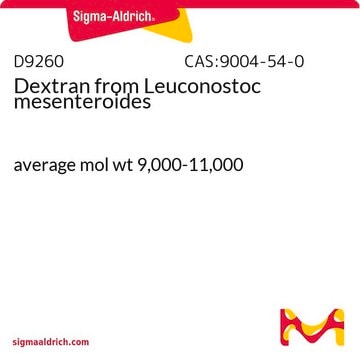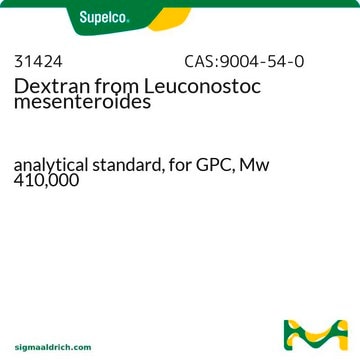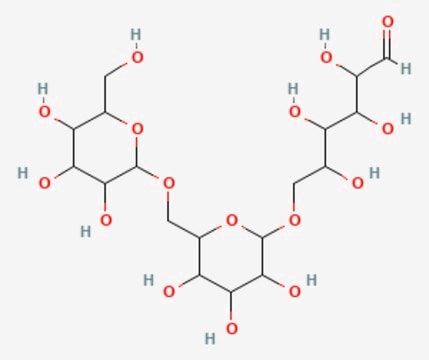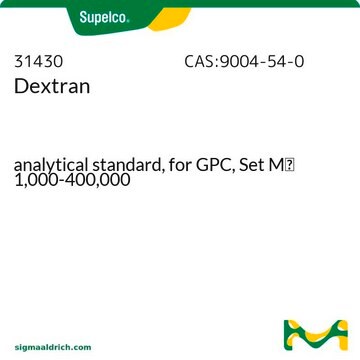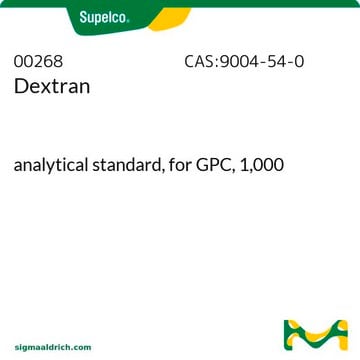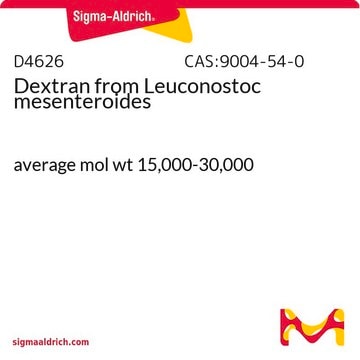D5376
Dextran from Leuconostoc mesenteroides
average mol wt 1,500,000-2,800,000
Synonym(s):
6-O-(6-O-beta-D-Glucopyranosyl-beta-D-glucopyranosyl)-D-glucose, Manninotriose
About This Item
Recommended Products
biological source
bacterial (Leuconostoc mesenteroides)
form
powder
optical activity
[α]/D 199°
mol wt
average mol wt 1,500,000-2,800,000
technique(s)
gel permeation chromatography (GPC): suitable
color
white
application(s)
advanced drug delivery
agriculture
life science and biopharma
microbiology
storage temp.
2-8°C
InChI
1S/C18H32O16/c19-1-5(21)9(23)10(24)6(22)3-31-17-16(30)14(28)12(26)8(34-17)4-32-18-15(29)13(27)11(25)7(2-20)33-18/h1,5-18,20-30H,2-4H2
InChI key
FZWBNHMXJMCXLU-UHFFFAOYSA-N
Looking for similar products? Visit Product Comparison Guide
General description
Application
Dextrans of less than 60,000Da are generally considered low molecular weight dextrans. Low molecular weight dextrans are often preferred versus high molecular weight dextrans due to their viscosities, aggregation and permeation properties. High molecular weight, water-soluble, dextran polymers have been used in a wide variety of biomedical applications. Dextran (1500-2800), a high molecular weight dextran, may be used to induce blood aggregation and as a high viscosity plasma expander (HVPE).
Biochem/physiol Actions
- Osmotic Balance: Dextran helps maintain osmotic balance by increasing the solute concentration in a solution. This prevents excessive water movement across cell membranes, thus maintaining cell integrity and function.
- Cryoprotection: Dextran acts as a cryoprotectant by forming a protective barrier around cells and tissues during freezing. This barrier inhibits the formation of ice crystals, which can damage cell membranes and structures.
- Viscosity Control: Dextran can alter the viscosity of solutions by increasing the molecular weight of the solution. This change in viscosity affects the flow properties of the solution, making it useful for controlling the thickness of solutions in various processes.
- Drug Delivery: Modified dextran serves as a carrier for controlled drug delivery. Dextran can encapsulate drugs and release them gradually, enhancing drug solubility and controlling the release profiles to improve therapeutic outcomes.
- Gel Electrophoresis: Dextran increases the density of sample-loading solutions in gel electrophoresis. This increased density helps samples sink into the gel matrix, allowing for more precise separation of molecules based on size and charge during electrophoresis.
- Enzyme Stabilization: Dextran stabilizes enzymes by providing a protective environment. It forms a stable matrix around enzymes, enhancing their activity and extending their lifespan in various biochemical reactions. This protection prevents enzyme denaturation and inactivation, allowing enzymes to function more effectively.
Features and Benefits
- Dextran with an average molecular weight range of 1,500,000-2,800,000
- Freely soluble in Water, DMSO, formamide, ethylene glycol, and glycerol
- Versatile and adaptable for a wide variety of laboratory and research applications
Preparation Note
Other Notes
Comparable product
Storage Class
11 - Combustible Solids
wgk_germany
WGK 2
flash_point_f
Not applicable
flash_point_c
Not applicable
ppe
Eyeshields, Gloves, type N95 (US)
Certificates of Analysis (COA)
Search for Certificates of Analysis (COA) by entering the products Lot/Batch Number. Lot and Batch Numbers can be found on a product’s label following the words ‘Lot’ or ‘Batch’.
Already Own This Product?
Find documentation for the products that you have recently purchased in the Document Library.
Customers Also Viewed
Protocols
Dextran polymer details: composed mainly of alpha-D-(1-6) linkages with varied branch lengths.
Related Content
Dextrans are polysaccharides with molecular weights ≥1,000 Dalton, featuring a linear backbone of α-linked d-glucopyranosyl repeating units.
Our team of scientists has experience in all areas of research including Life Science, Material Science, Chemical Synthesis, Chromatography, Analytical and many others.
Contact Technical Service


